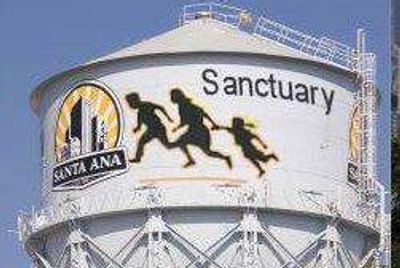
04 March 2017
TRENDING
SANTA ANA, Calif. — Cities of immigrants, it's time. Time to declare yourselves sanctuaries. To wear the label proudly, defiantly, even if the White House and its allies threaten you and utter all kinds of falsehoods against you.
President Trump is in power; his nativist ideology is now fully armed and operational. He laid it out with alarming clarity in his "America first" address to Congress this week, painting unauthorized immigrants as vicious criminals, and refugees as dangerous undesirables, using both groups as scapegoats and targets.
The homeland security secretary, John Kelly, has given his boss a battle plan. Immigration and Customs Enforcement and the Border Patrol are carrying it out, combing the country, seizing and terrifying the innocent.
The sweeps, arrests and intimidation share a brutal randomness.
A young "Dreamer" gives a news conference after her father and brother are detained — and is arrested herself.
ICE stakes out a courthouse to grab a survivor of domestic violence. Border agents ask a planeload of passengers — on a domestic flight — to show their papers.
Many people are confused by the term "sanctuary city," which has no strict definition.
Mr. Trump uses it as an epithet to mean immigrant-loving communities that allow alien criminals to roam free. Used that way, the label is false; no city can suspend the rule of law or keep out the feds.
But rather than tolerating such slander, cities should seize back the term, defining sanctuaries as places that stand for reason in the face of overreaching, unjust and often lawless federal enforcement.
They should do what Santa Ana, Calif., has done.
It is a city of 335,000, in the heart of Orange County, whose City Council has passed one of the boldest and most far-reaching sanctuary ordinances in the state.
In a county that has long been known as a haven of white Republicans, Santa Ana is a mixed-race, mixed-income, All-American town.
Its population is about 46 percent immigrant, and its mayor and its six City Council members are all Latino.
When the Council gave final approval to its sanctuary ordinance in January, by a 6-to-0 vote, it was the culmination of months of persuasion by residents who feel the force of Mr. Trump's anti-immigrant threats intimately.
They argued that Latino and Asian families, including many unauthorized immigrants with citizen children, have fought for a foothold in this country and deserve to live in safety and peace. They pointed out that using the local police as immigration enforcers takes them away from their primary responsibility, the safety of the community. It wastes crime-fighting resources. It costs too much. And it's constitutionally dubious for localities to detain people for no other reason than an administrative request from ICE.
The ordinance is duly respectful of the law, in a spirit that honors the Constitution and residents' civil rights.
It declares that none of its provisions are to conflict with "any valid and enforceable duty and obligation imposed by a court order or any federal or applicable law."
But it also makes clear that the city will not cooperate in any federal immigration dragnet.
The feds may do what they will, but Santa Ana wants no part of it.
It will not allow the use of city resources or personnel to assist in these efforts unless required by state or federal law. Nor will the city share "sensitive information," protecting the privacy of its residents, whatever their immigration status.
Police chiefs and sheriffs across the country understand such reasoning; 63 of them recently sent a letter opposing Mr. Trump's effort to conscript them for his immigration crackdown.
Santa Ana's decision took courage, given Mr. Trump's heated language about "vicious" immigrant criminals and his threat to rob sanctuary cities of federal funds. It's not clear that he can or will follow through. But for Santa Ana, other financial implications were more immediate: The city had a deal with ICE to house immigrant detainees in its jail for $340,000 a month; that contract has been canceled. The city accepted the hit, realizing how inappropriate it would be to call itself a sanctuary while profiting from Mr. Trump's deportation policies.
Success has encouraged the residents of Santa Ana to consider the next steps.
Now that we're a sanctuary city, what else should we do? How about finding lawyers to help people in detention fight deportation?
A resolution to examine the issue came before the Council the other night. Students, lawyers and community members waited through hours of legislative minutiae for a chance to testify. At about 12:30 in the morning, the resolution passed unanimously.
The opposition in California to the Trump administration goes well beyond a blue island in historically red Orange County.
The State Legislature is considering a strong sanctuary bill, the California Values Act, to prohibit the use of state resources for immigration enforcement.
Like Santa Ana's ordinance, the Values Act would have the force of law.
Pressure for sanctuary policies is strong in Los Angeles, too, even though its mayor, Eric Garcetti, has at times been wary of the label.
Nervous politicians should get over their qualms.
While they have been tiptoeing, the Trump administration has been moving.
This editorial by Lawrence Downes appeared in the March 3, 2017 New York Times under the name, A 'Sanctuary City' seizes the moment, and the name.
###
March 4, 2017